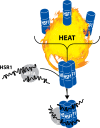Non-coding RNAs turn up the heat: an emerging layer of novel regulators in the mammalian heat shock response
- PMID: 24002685
- PMCID: PMC3933615
- DOI: 10.1007/s12192-013-0456-5
Non-coding RNAs turn up the heat: an emerging layer of novel regulators in the mammalian heat shock response
Abstract
The field of non-coding RNA (ncRNA) has expanded over the last decade following the discoveries of several new classes of regulatory ncRNA. A growing amount of evidence now indicates that ncRNAs are involved even in the most fundamental of cellular processes. The heat shock response is no exception as ncRNAs are being identified as integral components of this process. Although this area of research is only in its infancy, this article focuses on several classes of regulatory ncRNA (i.e., miRNA, lncRNA, and circRNA), while summarizing their activities in mammalian heat shock. We also present an updated model integrating the traditional heat shock response with the activities of regulatory ncRNA. Our model expands on the mechanisms for efficient execution of the stress response, while offering a more comprehensive summary of the major regulators and responders in heat shock signaling. It is our hope that much of what is discussed herein may help researchers in integrating the fields of heat shock and ncRNA in mammals.
Figures





References
Publication types
MeSH terms
Substances
LinkOut - more resources
Full Text Sources
Other Literature Sources

